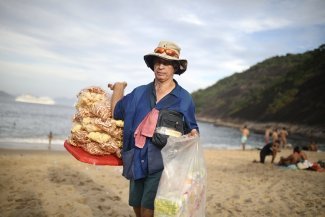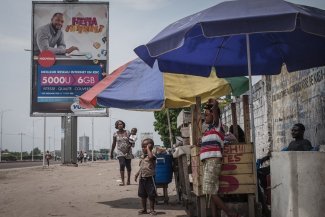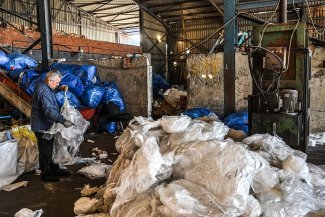Both the leaders, and the ordinary people, of countries in fragile contexts are responsible for breaking the fragility trap.
Three years into implementation of the 2030 Sustainable Development Goals (SDGs), the Organisation for Economic Co-operation and Development (OECD) warns that we are already off-track. Worse, without action, over 80 per cent of the world’s poorest people will live in fragile contexts by 2030. The OECD believes fragility poses a major global threat to the implementation of the 2030 Agenda for Sustainable Development. The OECD uses ‘fragile contexts’ because fragility is hard to define, and our understanding constantly evolves. More countries object to the ‘fragile state’ label, which they say stigmatises them. So, in its States of Fragility 2018 report, the OECD identifies 58 contexts classified as fragile in a framework it has developed since 2016. Fragility covers political, economic, societal, environmental, and security dimensions. These 58 contexts include Syria, the Democratic Republic of Congo, Venezuela, Yemen, Laos, Solomon Islands, Rwanda, Tanzania, and Sierra Leone.
Fragility can wreak havoc, even in countries that have strong institutions, countries that are middle-income, and that aren’t at war. All forms of fragility matter, be it chronic fragility or ‘fragility-lite’. In whatever way it manifests itself, fragility is a slippery slope.
However, we tend to associate fragility with violent conflict and its aftermath – and with good reason. In 2016, according to the OECD, “more countries experienced some form of violent conflict than at any time in the past 30 years. Close to 26,000 people died from terrorist attacks and 560,000 people lost their lives because of violence. The number of displaced people in the world is the highest since the end of the Second World War. Last year, the world faced four concurrent famines.”
The fragility trap
The development industry is notorious for working through faddish topics the way the fashion industry devours the hottest new designs on the catwalk. But concern about fragility under different guises has endured. And the OECD isn’t alone in raising alarms about fragility. The International Growth Centre (IGC) hosted by the London School of Economics and Oxford University set up the Fragility Commission on State Fragility, Growth and Development chaired by the former British Prime Minister David Cameron and co-chaired by former president of the African Development Bank, Donald Kaberuka.
In Escaping the Fragility Trap, the Fragility Commission identifies five interlocking elements of this trap. First, fragile states make up subgroups with oppositional identities that militate against a shared national identity, vision, or project. Rather, these groups take turns to capture and plunder the state in a way that suggests “it’s our turn to eat” as the journalist Michela Wrong wrote in her book of the same title. Second, citizens do not view the state as legitimate and refuse to comply.
Third, the state lacks capacity. It cannot deliver basic services, caused by the first two factors, and so is irrelevant to the lives of most citizens (it’s a predatory burden). Poorly delivered infrastructure, health, education and security, for example, further weaken the state.
Public officials owe more allegiance to their subgroups so feel no compunction to serve a national project. Underpaid, they lack motivation. Fourth, these earlier problems reduce provision of security and lead to violence. Subgroups contest to capture the state and no unifying national project exists. Fifth, the private sector is weak. The instability, capacity constraints, poor provision of infrastructure, low health indices, low-skilled workforce, and rent-seeking by public officials shape the private sector’s character and investors willing to take risks in such an environment. Such a private sector does not hire many workers, pays limited revenue to state coffers, and does not produce much for either the domestic or external market.
This is a self-reinforcing vicious cycle. It is difficult to escape. Reformers who treat the problems as unrelated and linear tackle a subset of symptoms, not causes. As a result, they not only fail, they often make things worse. This is a systemic challenge of enormous complexity: at once a problem of politics, history, economics, norms and values, and much more. Unless tackled systemically, the prospect of an escape from the fragility trap is slim.
This puts the spotlight on the leadership of states facing fragile contexts to break the cycle. Although foreign investment and aid help, external actors can do little in the absence of leadership with the vision and drive to take their country forward.
Homegrown solutions
Visiting Sierra Leone to mark the launch of the Fragility Commission’s global report and Sierra Leone case study, Kaberuka was emphatic that “solutions must come from within. External solutions don’t work.” And if people come with external solutions and money, “stand your ground: walk away from money if comes with external solutions. You have to make tough choices,” Kabureka advised.
During his time as the finance minister of his native Rwanda, Kabureka told the story of his country’s negotiations with the British government under Tony Blair’s premiership, just a few years after the 1994 genocide: “The British government asked us what we were prepared to do. In response we gave them a page of our priorities and what we knew we could deliver”. As a result, the British government committed to a decade of long-term, predictable funding to support Rwanda, with progress subject to third-party evaluation by the UK-based Institute for Development Studies.
Today, conditions for such a ‘mutual accountability framework’ are themselves fragile. Although the so-called New Deal – between a group of 20 fragile and conflict-affected states (known as the g7+) and their international partners – commits both sides to a set of principles to support country leaderships and their systems, after years of recession and cutbacks following the 2008 financial crisis, taxpayers in rich countries are more sceptical about the benefits of aid. A rising wave of nationalism and retreat from a multilateral, interdependent world is causing bilateral aid donors to be jittery. They are back to bypassing the state, delivering aid through international NGOs and consultancies that they trust more than governments, terrified of the headline in a right-wing, aid-bashing newspaper citing the misuse of aid by greedy, corrupt politicians.
The onus is on the leaders of countries in fragile contexts. Looking back over her 12 years leading another fragile country, former President Ellen Johnson Sirleaf of Liberia mused that she tackled the “hard” issues of infrastructure, roads, power but where she “failed, maybe, was in dealing with the softer issues: values, attitudes, norms.”
But even if by her own assessment, her legacy is mixed, Sirleaf had a good measure of the challenges she faced. When accepting her Mo Ibrahim Foundation’s Ibrahim Prize for Achievement in African Leadership, she noted: “Political parties are organised by patronage and patriarchy” while states are facing “the challenge of institutional and systemic corruption, an ill that fights back, often with an overpowering resistance of strength.”
Back in 2007, not long into her first term as Liberia’s president, Sirleaf noted the need for a “national leadership system”. She’s right: transforming these states of fragility isn’t the job of just the woman or man at the top – all of society has to dig in.
The Fragility Commission’s Sierra Leone case study traces the roots of fragility to British colonial rule, which created a Westernised bureaucratic formal state, which it controlled directly and indirectly through traditional tribal chiefs and subjects in a Protectorate. Both decolonisation and the post-war reconstruction that has taken place since 2002 left this basic formal/informal dichotomy intact.
The result is a lack of a national identity or ‘project’ around which to coalesce the energies of diverse citizens. The new government sworn into power after an election that reminded citizens of the country’s enduring fragility plans to create an Independent Commission for Peace and National Cohesion. Though welcome, ordinary Sierra Leoneans now realise that they cannot leave efforts to build a resilient society to their politicians alone. Too often, newly-installed political leaders face a dilemma: they recognise the need to break the cycle of fragility, but they want to consolidate power and limit the opposition’s scope to thwart their plans. As a result, they often recreate the pattern they have vowed to eliminate.
Fragility is complex, adaptive, and resistant to progressive change. That’s why citizens of countries in fragile settings must take charge to find solutions and to become better systems thinkers, as well as leaders, in order to break the fragility trap.










